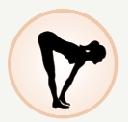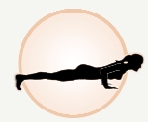
Sun Salutations
The Sun Salutation, or Surya Namaskar, is the most familiar of all yoga vinyasas. Literally translated, Surya Namaskar means “Beautiful light, you are my own Self” (Stiles 2000). In Hindu mythology, the sun god Surya symbolized health and immortal life. Namaskar stems from the Sanskrit word namas, which means “to bow to” or “to adore” and is also the root of the familiar yoga greeting, “Namasté” (Rosen 2010). Just as the sun is a source of health and vitality, so too is the performance of sun salutations.
Sun salutations, often as complex as they are beautiful, can be a complete practice in themselves. Alternatively they can be used as the opening segment of any yoga practice, to set the rhythm and mood of the poses that follow. Surya Namaskar A and B (see the sidebar “Three Variations of Sun Salutation”) comprise the foundation of ashtanga yoga, with poses added into the sequences to enhance the practice. Sun salutations typically alternate spinal flexion with spinal extension, promote strength and flexibility, warm the body and can benefit the cardiovascular system.
A classic salutation is really a group of individual asanas performed as one complete and repeating series, or vinyasa. Performed correctly, the flowing movements can appear easy. However, each pose has specific alignment requirements that are essential in order to achieve the intended benefits of the sequence without injury or strain. There are many variations of the sun salutation, although a lot of the poses in each one are quite similar. Let’s take a closer look at some specific poses that seem to predominate, and then put these together to create three sun salutations that enjoy wide popularity today (Ellison 1996; Yoga Journal 2010; Silva & Mehta 1990). Illustrations of the poses and Web animations of the sun salutation sequences follow the pose descriptions.
Sun Salutation Poses
MOUNTAIN POSE (TADASANA)
Benefits
- Establishes symmetrical neutral alignment.
- Allows time to develop inward focus and to establish practice intention.
- Increases awareness of body alignment and comfort.
Alignment and Cues
- Keep arches lifted, weight evenly distributed on triangle of heel, ball of foot at big toe, and ball of foot at little toe.
- To avoid hyperextending knees, align hips over ankles and align knees between.
- Lift breastbone, open chest, and lengthen back of neck.
- Position hands in namasté (prayer pose) or by sides, palms in.
Contraindications and Modifications
Modify for dizziness or difficulty standing by doing pose seated in chair.
TALL MOUNTAIN (URDHVA HASTASANA)
Benefits
- Initiates mild spinal extension.
- Helps lengthen and open front torso, chest and shoulders, and opens lower ribs for fuller expansion of lungs.
Alignment and Cues
- Inhale and keep head in alignment with spine as it extends.
- Keep shoulders down as arms lift out to sides and overhead.
- Keep chest lifted, pelvis neutral, tailbone down.
Contraindications and Modifications
Modify range of motion as needed (e.g., for previous shoulder or neck injuries) as arms lift overhead.
CHAIR POSE (UTKATASANA)
Benefits
- Strengthens ankles, thighs, calves and spine.
- Stretches shoulders and chest.
- Promotes balance and stability.
Alignment and Cues
- Inhaling, bend knees and lower body as if sitting in chair.
- Raise arms overhead, palms facing in, and draw shoulders down.
Contraindications and Modifications
Modify range of motion for tight calves. Students with tight latissimus dorsi or upper back can lower arms and bend elbows to keep spine straight.
FORWARD FOLD (UTTANASANA)
Benefits
- Stimulates circulation and creates traction on spine.
- Stretches hamstrings, calves and hips.
- Provides weight-bearing hip extensor stretch when tailbone is lifted further.
- Reduces stress.
Alignment and Cues
- Exhaling, hinge from hips with neutral back.
- Let arms sweep down, and place hands on floor. Release back during last third of movement.
- Emphasize lengthening front of torso as you move deeper into pose.
Contraindications and Modifications
Modify for tight hamstrings or prior back injuries either by bending knees to rest ribs on thighs or by using wall for support (hands resting on wall, back aligned parallel to floor).
STANDING HALF FORWARD BEND (ARDHA UTTANASANA)
Benefits
- Reinforces neutral in “antigravity” position.
- Stretches hamstrings and promotes pelvic mobility.
- Helps teach distinction between hip and spine flexion.
Alignment and Cues
- From forward fold, inhale and extend spine, lifting breastbone and drawing shoulder blades down.
- Distribute weight evenly over feet, with knees straight and hands on floor.
Contraindications and Modifications
Modify for tight hamstrings by bending knees as necessary. Lift hands to yoga blocks or thighs if spine extension is otherwise restricted.
PLANK POSE (CHATURANGA DANDASANA)
Benefits
- Stabilizes entire torso against gravity.
- Strengthens arms and wrists.
- Integrates core strength with arm strength in various positions.
Alignment and Cues
- Exhale and step or jump back into lower push-up position, hands under shoulders, front of shoulders open and square.
- Use abdominals to support spine, without swaying.
- Maintain neutral alignment of head, neck and spine.
Contraindications and Modifications
This pose may not be appropriate for students with carpal tunnel syndrome or other wrist injuries. Modify by bringing knees to mat or performing with hands on wall, chair or yoga blocks.
UPWARD-FACING DOG (URDHVA MUKHA SVANASANA)
Benefits
- Improves posture by strengthening spine extensors, scapular stabilizers, shoulders and arms while stretching front of shoulders, chest and upper abdominal area.
- Stretches hip flexors and counterbalances flexed postures of daily life.
Alignment and Cues
- Inhale, flatten tops of feet on mat and lift torso upward and back, rolling shoulders.
- Keep hips on mat, legs active and stretching away from torso.
- Keep hands in line with shoulders and glutes contracted.
- Lengthen torso away from lumbar spine to avoid compression.
Contraindications and Modifications
This pose may not be appropriate for students with back or wrist injuries. Modify spinal extension by decreasing range of motion. Modify weight bearing on wrists by placing push-up bar or yoga blocks under hands.
DOWNWARD-FACING DOG (ADHO MUKHA SVANASANA)
Benefits
- Relieves spinal compression.
- Strengthens arms while stretching shoulders, hamstrings, calves and arches.
- Improves upper- and lower-body flexibility in weight-bearing positions.
Alignment and Cues
- From upward-facing dog, lower torso and tuck toes under.
- Exhale and lift tailbone toward ceiling while straightening arms, bringing body into inverted V shape.
- Position head between arms with neck relaxed.
- Lift abdominals, and move torso toward thighs.
- Spread fingers apart and distribute weight across entire hand, not just through wrist.
- Press heels downward as tailbone reaches upward.
Contraindications and Modifications
Inverted positions may not be appropriate for students with glaucoma or vertigo. Modify by bending knees as necessary to maintain neutral spinal alignment. Decrease pressure on wrists by placing hands on yoga blocks inclined against wall. Pose may be performed with arms resting on table, wall or chair.
WARRIOR 1 (VIRABHADRASANA 1)
Benefits
- Stretches hip flexors and adductors of rear leg.
- Strengthens front leg.
- Stretches anterior torso while strengthening extenders of spine.
Alignment and Cues
- From down dog, inhale and step right foot forward between hands and turn left foot to 60-degree angle, with little-toe side of foot flat on mat.
- Lift torso and raise arms overhead, palms together.
- Keep hip bones square to front. Look up and draw shoulder blades down.
Contraindications and Modifications
Modify for previous shoulder injuries by keeping arms shoulder width apart. Students with tight latissimus dorsi and/or thoracic spine may improve spinal alignment by bending elbows and lowering them to shoulder level, pulling down and back to open the chest.
LOW LUNGE (ANJANEYASANA)
Benefits
- Stretches anterior chain (neck, chest, abdominals, hip flexors, quadriceps, tibialis and top of foot).
- Fosters mobility of ankle joints and improves posture.
Alignment and Cues
- From down dog, inhale and step forward. Place right foot between hands, knee over ankle.
- Lower left knee to floor, and slide it back until you feel stretch along front of leg.
- Inhale and extend spine, lifting breastbone and bringing arms overhead.
- Draw shoulder blades down, and place top of left foot on floor.
Contraindication and Modifications
Place towel under weight-bearing knee, as needed for cushion.
Putting the Sun to Work for You
For a stand-alone practice, perform the basic sun salutation and then each of the illustrated variations (see the sidebar “Three Variations of Sun Salutation”), beginning with 3–5 rounds each and working up to a 20- to 30-minute practice.
As a functional mind-body warm-up for other activities, mix and match the salutations or perform a single one for 8–10 minutes.
At the beginning of a yoga practice, three rounds of each salutation will prepare your body for more intense poses in a style of your own choosing.
- Relax shoulders down.
- Lift breastbone.
- Align hip bones over ankles.
- Lift arches, keeping equal weight through whole foot.
- Look upward and lift breastbone.
- Draw shoulders down as arms lift up.
- Maintain equal weight distribution.
- Keep tailbone lifted.
- Extend spine.
- Look forward and lift breastbone.
- Lift kneecaps.
- Keep tailbone lifted.
- Hinge from hips, releasing into flexion during last third of movement.
- Relax head down.
- Lift kneecaps.
- Lift breastbone, extend spine and reach arms up.
- Reach back with tailbone.
- Keep knees and feet together.
- Align ears with shoulders.
- Distribute weight through whole hand, not just wrist.
- Draw shoulder blades down.
- Keep elbows close to rib cage.
- Press heels away.
- Look upward.
- Keep hands aligned with shoulders.
- Rotate shoulders out, with no compression.
- Point toes.
- Keep tailbone lifted.
- Put weight on base of fingers.
- Press ribs toward thighs, and lift kneecaps.
- Bend knees, if necessary, and press heels toward floor.
- Look upward and lift breastbone.
- Square hips to front.
- Keep outside edge of foot pressing to mat.
- Draw shoulder blades down as arms lift up.
- Extend spine.
Sun Salutation A. The basic sun salutation.
Sun Salutation B. A longer version that replaces tall mountain pose with chair pose and adds warrior 1 following downward-facing dog. After you perform warrior 1 on the right side, go back to chaturanga, upward-facing dog and downward-facing dog, and perform warrior 1 on the left side. Go back to chaturanga one more time and complete the circle. Salutation B sets up the method of flow for ashtanga and flow yoga sequences.
Sun Salutation C: Sivananda Salutation. From the Sivananda style of yoga. Deepen the back extension in tall mountain pose. Replace chaturanga with a straight-arm plank, and place knees, chest and chin on the mat. Continue through the circle to complete the salutation. This is an excellent alternative for people who can’t or don’t want to practice chaturanga, and it provides a thorough preparation for a leg-intensive practice.
@VIDEO_FILE:/files/video/201006ifjsuna2.mp4:300:375:autobuffer=1:buffer=2:startbuffer=3@
@VIDEO_FILE:/files/video/201006ifjsunb2.mp4:300:375:autobuffer=1:buffer=2:startbuffer=3@
@VIDEO_FILE:/files/video/201006ifjsunbsiv2.mp4:300:375:autobuffer=1:buffer=2:startbuffer=3@









